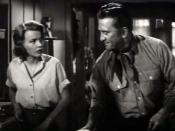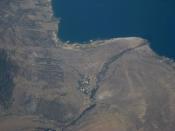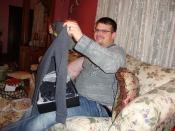Exposition in True West, or The World Outside of Mom's Kitchen.
Rachel Aaron Exposition in a play is always important, but it is especially so when the entire play takes place in a kitchen. Without exposition revealing why we are in the kitchen, how the characters in the are related, what has passed between them before, and so on, how could the playwright hope to keep the audience's interest for the first fifteen minuets, much less for two hours. Exposition gives a background both to the plays events and to the characters which makes the play interesting.
The first type of exposition is the exposition of action. What happened to these people before we see them on stage? What is their history? What are they doing here? In True West, we as the audience, discover that the two people on stage are brothers in the first line, "So, Mom took off for Alaska, huh?"ÃÂ They share a mother, so we assume they are brothers.
We can also assume that they haven't seen each other in awhile, because Lee has to ask where his mother is, so he obviously hasn't been hanging around. In line 107, we find out that Lee hasn't been around for five years. We can see that one of them is a writer, and later it is revealed that he writes scripts. Lines 126-129 are a major bit of plot exposition; Lee: You may be able to get away with that with the old man. Git him tanked up for a week! Buy him off with yer Hollywood blood money, but not me! I can get my own money my own way. Big money! This is a good example of how the playwright uses exposition to move the play ahead. By having Lee say these few lines, we learn something about the brother's previous interactions with each other and with their drunkard father. It also lets us know about Lee's line of work. "How will he make that big money?"ÃÂ we wonder, our interests have been piqued, and we pay attention. In these three lines, we have discovered action in the past and this lets the play move forward to action in the future with a background for it to stand on.
Character exposition is subtler and often takes the form of a story told by one of the characters. These events may have nothing to do with the action of the play, but instead, reveals character that will drive future action. For example, starting at line 135 and ending at 145, Lee's retelling of "Lonely are the Brave"ÃÂ serves absolutely no plot purpose. So, why have it in there? Lee, the lonely drifter, relates with an exacting nostalgia how Kirk Douglas's "eye's die"ÃÂ when he hears the shot that kills his horse. This tells the audience more about Lee's character and his real adherence to the Western mythos. This makes his later actions plausible in a way that would not have been possible without this character exposition.
There is much more exposition in True West than is mentioned here, both action and character, but these are examples of how exposition is used in the play to propel the future action. Both the first and second types of exposition are of vital importance to the play's future action, particularly since there is only one set. Onstage exposition of offstage action, like the golf game with Saul, or the theft of the toasters, is necessary for the continuance of the play and Shepard knows this, that's why he puts it in. At the same time, the exposition of character through stories and tangents, though they may have little to do with the present action, is also of vital importance. How would the play have progressed if the audience knew nothing of Austin's dreams of his resentment of Lee? Many of his actions wouldn't have made sense. Good exposition that is informative without sounding contrived or forced is necessary to propel the future action of the play. Otherwise it's just a pair of guys with no past playing with toasters and making a mess.





